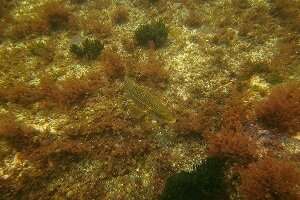L. bergylta spotted morphotype. Foto: Olga Reñones
Not all individuals of the same species are identical: There is a marked variability within the same population, and sometimes, these morphological differences are translated into a different behavior. A study by the UB shows that fishing alters resource distribution and therefore the behavior of two typologies of the same fish species, Labrus bergylta. These results, published in the journal Marine Ecology Progress Series, show that fishing hardens the understanding of how the features of species have evolved in exploited ecosystems, since it has an impact on how they act and feed from animals. Also, results ratify the importance of marine reservoirs to understand the original behavior of these ecosystems before human intervention.
The article is signed by Lluís Cardona, Àlex Aguilar and Fabiana Saporiti researchers from the Department of Evolutionary Biology, Ecology and Environmental Sciences and the Biodiversity Research Institute (IRBio) of the UB. Experts from the Spanish Institute of Oceanography and the University of Essex (United Kingdom) also took part in the study.
The existence of different forms of the same species, called morphotypes, is common in vertebrate animals and depends to a large extent on the abundance of available prey during the first years of life, as well as on competition with other congeners. To find out if two morphotypes of the same species differ in the use of resources and if this diversity is affected by fishing, the UB team launched a study on Labrus bergylta, a fish in the order of Perciformes and the family of the wrasses, very common on the northern coasts of the Iberian Peninsula and on the Atlantic coasts of Europe.
The researchers compared the middle patterns of use and the feeding of two morphotypes of this fish—one plain and the other with spots—in two different habitats: in the Cíes Islands (Vigo), a protected marine area where recreational fishing is not allowed, and in contiguous areas open to fishing. With this aim, they first studied visually the number of specimens of each morphotype in the two areas and then used stable isotope analysis techniques of carbon and nitrogen to find out the differences in the type of feeding.
Fishing exploitation hardens the understanding of original trophic niches
The results show that the two morphotypes differ consistently in their use of the habitat both inside and outside the marine reserve, but only in the marine reserve do they also differ in their diet. According to the researchers, this is because of fishing: by reducing the size of the population, it reduces intraspecific competition. "The distribution of resources between these two varieties depends on the density, so the current behavior in areas open to fishing is not informative about their original trophic niches. This shows that many of the features that we see in exploited wild species may have more to do with that exploitation and not with adaptations to the natural environment, since it has been transformed by humans," says Lluís Cardona.
These conclusions show the importance of protected areas to understand the behavior of marine species. "Comparing the biology of the species inside and outside the marine reserves and other protected areas allows us to understand the changes in the biology of the exploited species, which otherwise would not be clear," highlights Lluís Cardona.
Given the situation, the authors point out the importance of analyzing how these changes are transferred to the rest of the trophic web and see if the same happens with other species in other regions. "This is particularly relevant for the North Atlantic Ocean, where a century of intense human exploitation has decimated the populations of most long-lived marine species," concludes the researcher.
More information: L Cardona et al. Fishing alters resource partitioning between color morphs in a temperate coastal fish, Marine Ecology Progress Series (2020). DOI: 10.3354/meps13440
Journal information: Marine Ecology Progress Series
Provided by University of Barcelona
























